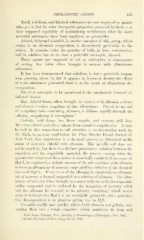Page 437 - My FlipBook
P. 437
'
THERAPEUTIC AGENTS. 435
lodol, iodoform, and kindred substances are not employed as germi-
cides per se, but for other therapeutic properties possessed by them, e. g.
their supposed capability of maintaining sterilization after the more
powerful antiseptics have been employed as germicides.
Aristol, dithymol biniodid, is another member of this group, which
owing to its chemical composition is theoretically preferable to the
others. It contains twice the quantity of iodin in loose combination,
and in addition has as its base a powerful antiseptic, thymol.
These agents are supposed to act as antiseptics in consequence
of setting free iodin when brought in contact with albuminous
substances.
It has been demonstrated that iodoform is not a germicide (organ-
isms growing about it), but it appears to lessen or destroy the eifects
of toxic substances generated about it as the result of albuminous de-
composition.
The final antiseptic to be mentioned is the mechanical removal of
infected tissues.
Zinc chlorid forms, when brought in contact with albumin, a dense
and almost colorless coagulum of zinc albuminate. Placed at one end
of a capillary tube containing albumin, it diffuses rapidly through the
solution, coagulating it throughout.
Carbolic acid forms less dense coagula, and creosote still less.
Mercuric chlorid and silver nitrate form complete coagula also. It may
be well in this connection to call attention to an observation made by
Dr. Kirk, in an essay read before the First District Dental Society of
New York, that coagulation is a chemical process, as illustrated in the
union of mercuric chlorid with albumin. The metallic salt does not
act by catalysis, but there is a distinct quantitative relation between the
coagulant and the coagulable material, the process ceasing when the
quantitative relation of these bodies is chemically satisfied ; if an excess of
HgClo be employed, a definite amount of the salt combines with albumin
to form an albuminate of mercury suspended in a solution of the cliemical
excess of HgCU. If an excess of the albumin be employed, an albumin-
ate of mercury is formed suspended in a solution of albumin. The albu-
minate of mercury when brought in contact with an easily decomposable
sulfur compound may be reduced by the formation of mercury sulfid
and the albumin be restored to its primary condition,^ which would
seem to indicate that HgCla is an unreliable germicide where putrefac-
tive decomposition is in progress giving rise to HjS.
Formalin readily and quickly aifects both albumin and gelatin, con-
verting them into a tough coagulum which maintains its form and
^ Prof. James Truman, Proc. Academy of Stomatology of Philadelphia, Dec. 1894.
'^Abbott, Principles of Bacteriology, 3d ed., 1896.
THERAPEUTIC AGENTS. 435
lodol, iodoform, and kindred substances are not employed as germi-
cides per se, but for other therapeutic properties possessed by them, e. g.
their supposed capability of maintaining sterilization after the more
powerful antiseptics have been employed as germicides.
Aristol, dithymol biniodid, is another member of this group, which
owing to its chemical composition is theoretically preferable to the
others. It contains twice the quantity of iodin in loose combination,
and in addition has as its base a powerful antiseptic, thymol.
These agents are supposed to act as antiseptics in consequence
of setting free iodin when brought in contact with albuminous
substances.
It has been demonstrated that iodoform is not a germicide (organ-
isms growing about it), but it appears to lessen or destroy the eifects
of toxic substances generated about it as the result of albuminous de-
composition.
The final antiseptic to be mentioned is the mechanical removal of
infected tissues.
Zinc chlorid forms, when brought in contact with albumin, a dense
and almost colorless coagulum of zinc albuminate. Placed at one end
of a capillary tube containing albumin, it diffuses rapidly through the
solution, coagulating it throughout.
Carbolic acid forms less dense coagula, and creosote still less.
Mercuric chlorid and silver nitrate form complete coagula also. It may
be well in this connection to call attention to an observation made by
Dr. Kirk, in an essay read before the First District Dental Society of
New York, that coagulation is a chemical process, as illustrated in the
union of mercuric chlorid with albumin. The metallic salt does not
act by catalysis, but there is a distinct quantitative relation between the
coagulant and the coagulable material, the process ceasing when the
quantitative relation of these bodies is chemically satisfied ; if an excess of
HgClo be employed, a definite amount of the salt combines with albumin
to form an albuminate of mercury suspended in a solution of the cliemical
excess of HgCU. If an excess of the albumin be employed, an albumin-
ate of mercury is formed suspended in a solution of albumin. The albu-
minate of mercury when brought in contact with an easily decomposable
sulfur compound may be reduced by the formation of mercury sulfid
and the albumin be restored to its primary condition,^ which would
seem to indicate that HgCla is an unreliable germicide where putrefac-
tive decomposition is in progress giving rise to HjS.
Formalin readily and quickly aifects both albumin and gelatin, con-
verting them into a tough coagulum which maintains its form and
^ Prof. James Truman, Proc. Academy of Stomatology of Philadelphia, Dec. 1894.
'^Abbott, Principles of Bacteriology, 3d ed., 1896.


